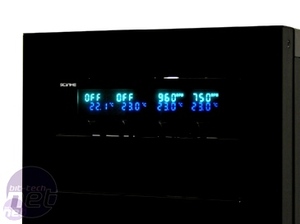
Installation
I decided to install the Kaze Master in a case we recently reviewed, The Lancool Metal Boned K7. The K7 performed well, but was penalised for being pretty noisy - a perfect candidate for a fan controller. Before installation, I fitted all eight fan connectors and temperature probes, and as expected, the mess of wiring from the back of the unit was significant – some serious cable hiding or liberal use of cable ties will be needed if you plan to keep your case tidy with the Kaze Master fitted.The mounting bracket is quite short, and only has two screw holes on either side, although this worked just fine in the LANCOOL. With the unit firmly secured into the case, I have to admit that it was looking great. However, I knew from personal experience that any case that utilises a drive rail based mounting system for 5¼" drives struggles with the typical short mount used by fan controllers, and the Kaze Master was no exception. I attempted to mount the unit into the front of a Antec P190, and as the drive rails only had one screw mount available, the unit felt significantly less secure and drooped noticeably.
With the K7 powered up using the old paper clip trick, the scythe came to life, and showed us just what a good looking piece of kit it is. The VFD readout looks great with bright clear displays of the fan RPMs and temperatures, and with perfect viewing angles from any side.
The control knobs (we couldn’t think of anything less silly to call them) offer a wide range of control over fan speeds, from the full 12v, all the way down to 3.7v, and even completely off.
This range of control really does put you back in command of your PC’s noise output, and is especially useful if you sleep in the same room as your PC – you can just leave it on overnight and easily switch off the fans. The difference between our 120mm fans at full and half speed was clearly audible (or inaudible, as they became very quiet indeed), and although this obviously compromises the CFM throughput, the Kaze Master lets you decide to what level you want to make that compromise.
The Kaze Master also has a neat alarm feature where if any connected fans fail or jam then an inbuilt alarm will sound, alerting you to the possible imminent catastrophic hardware failure (or just the need to buy a new exhaust fan.) This alarm can be disabled by removing a jumper on the PCB, and there’s also a jumper to switch the readouts from Celsius to Fahrenheit for our imperial system loving American chums.

Conclusion
The need for a fan controller will always come down to two things: the location of and how you use your PC. If (like me) you use it for a variety of purposes from high end gaming to low noise video playback, then grabbing one certainly makes sense. In this, the Scythe Kaze Master serves its purpose and well.However, onboard motherboard fan controls like ASUS’ QFAN technology have advanced a great deal recently, offering various profiles that will automatically adjust your fan speeds in line with a target temperature. These fanbuses are usually very adjustable within the operating system, and have been a common feature for years from some motherboard manufacturers.
However, for ease of adjustability and interface, a proper fan controller is still an attractive addition to most cases. Fortunately, the Kaze Master is a fine example. Well built, good looking and highly adjustable, the Kaze Master proves that there’s still life in fan controllers if you can justify the extra investment.
- Build Quality
- x
- x
- x
- x
- x
- x
- x
- x
- -
- -
- 8/10
- Ease of Use
- x
- x
- x
- x
- x
- x
- x
- -
- -
- -
- 7/10
- Features
- x
- x
- x
- x
- x
- x
- x
- -
- -
- -
- 7/10
- Performance
- x
- x
- x
- x
- x
- x
- x
- x
- -
- -
- 8/10
- Value
- x
- x
- x
- x
- x
- x
- -
- -
- -
- -
- 6/10
- Overall
- x
- x
- x
- x
- x
- x
- x
- -
- -
- -
- 7/10

MSI MPG Velox 100R Chassis Review
October 14 2021 | 15:04










Want to comment? Please log in.